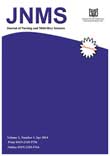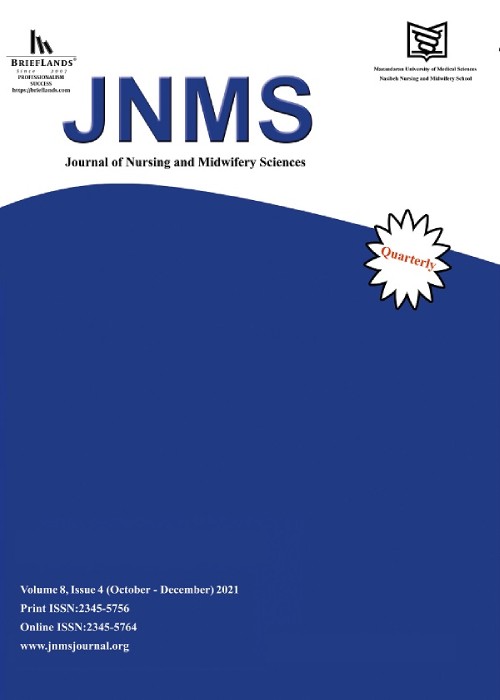فهرست مطالب

Journal of Nursing and Midwifery Sciences
Volume:3 Issue: 2, Apr-Jun 2016
- تاریخ انتشار: 1395/04/14
- تعداد عناوین: 8
-
-
Pages 1-10Background andPurposePrenatal health behaviors encompass different health-promoting behaviors in women of reproductive age, which improve physical and mental health, as well as pregnancy outcomes. This study aimed to evaluate the effect of prenatal training on the health-promoting behaviors of the women of reproductive age.Materials And MethodsThis randomized controlled clinical trial was conducted on 104 women of reproductive age in Sari city located in Mazandaran, Iran. Subjects were randomly divided into two groups of intervention and control. Inclusion criteria were willingness to have children, age range of 18-40 years, and overall physical and mental health. Data were collected using sociodemographic questionnaires and standard health promoting lifestyle (HPLP-II) questionnaire. In the intervention group, training was performed in four sessions (45-60 minutes) at one-week intervals focusing on health responsibility, physical activity and stress management. One month after the intervention, data analysis was performed using independent T-test, Mann-Whitney U test, Kruskal-Wallis test, Chisquare test, and mean, frequency, and standard deviation.ResultsAfter prenatal training, total score of health-promoting behaviors had a significant difference in the intervention and control group (151.60±17.503 vs. 139.42±19.596) (P=0.002). Mean score of health responsibility (27.75±4.066), physical activity (21.10±3.211) and stress management (23.19±3.036) were higher in the intervention group compared to the control group (23.90±5.032, 16.84±4.017 and 19.66±3.330, respectively), and the study groups had a statistically significant difference in this regard (PConclusionAccording to the results of this study, prenatal training could enhance health-promoting behaviors in women of reproductive age. Therefore, it is recommended that consultation and training sessions be considered during prenatal careKeywords: Health promotion, Health, promoting behaviors, Prenatal training, Reproductive age
-
Pages 11-18Background andPurposeSocial support is considered as a facilitator of health behaviors in women. This study aimed to evaluate and compare the status of social support and its associated dimensions in pregnant and non-pregnant women.MethodsThis analytical study was conducted on 310 pregnant and non-pregnant women referring to the health-care centers of Zarqan city in Shiraz, Iran in 2011. Participants were selected via convenience sampling. Data collection tools included demographic questionnaire and Social Support Appraisals (SS-A) scale. Data analysis was performed in SPSS V.16 using descriptive (frequency,percentage, mean, and standard deviation) and inferential statistics (Chi-square, T-test, and Pearsons and Spearmans correlationcoefficient).ResultsIn non-pregnant women, mean of the total social support was 40.08±2.80, and mean scores of support from friends, spouse, family and others were 12.08±1.33, 14.02±1.56, 14.53±0.96 and 13.54±1.09 respectively. Among pregnant women these values were 39.52±2.85, 11.72±1.59, 14.54±1.12, 14.38±1.06 and 13.41±1.18, respectively. The total support and support from friends were significantly higher in non-pregnant women compared to pregnant women (P = 0.05 and P = 0.03, respectively). On the other hand, support from the spouse was significantly higher in pregnant women compared to non-pregnant women (P = 0.01). Moreover, a significant correlation was observed between the total scores of social support and employment status of spouse among pregnant women (PConclusionAccording to the results of this study, there were significant differences in the total scores of social support and mean scores of support from the spouse and friends between pregnant and non-pregnant women. It seems that physical and psychological changes during pregnancy largely influence the perception of expecting mothers towards social support.Keywords: Social support in the pregnant, non, pregnant women, its associated dimensions
-
Pages 19-24Background andPurposeNosocomial infections, especially those occurring in intensive care units (ICUs), are one of the major health problems in every community. Nosocomial infections are associated with increased mortality rate and high treatment costs. Effective control of these infections essentially depends on the knowledge of healthcare providers regarding the detection and eradication of the associated causes. This study aimed to investigate the main challenges involved in the prevention and control of nosocomial infections in hospital ICUs.Materials And MethodsThis qualitative study was conducted on 21 healthcare providers selected via purposive sampling from various medical subgroups, including anesthesiologist, nursing managers, supervisors, faculty members, head nurses, and hospital managers. Data were collected via semi-structured interviews with the participants. Data analysis was performed using qualitative conventional content analysis.ResultsIn total, four main themes were emerged from conventional content analysis, as follows: 1) complex nature of work in the ICU; 2) lack of knowledge of healthcare providers; 3) inadequate equipment and resources and 4) human resource shortage.ConclusionAccording to the results of this study, appropriate resource allocation, improvement of organizational health structures, and competency of healthcare personnel in hospital ICUs could be remarkably effective in the prevention, control and reduction of nosocomial infections.Keywords: Intensive care units, Infection control, Nosocomial infections, Qualitative analysis
-
Pages 25-31Background andPurposeSpiritual health is one of the most critical health dimensions with remarkable influence on the life of individuals. Religion and spirituality play a pivotal role incoping with stressful events in life. This study aimed to evaluate the relationship between spiritual health and quality of life in patients with multiple sclerosis (MS).MethodsThis cross-sectional study was conducted on 223 patients at Mazandaran Multiple Sclerosis Association (MMSA), Iran in 2015.Participantswere selected via convenience sampling. Data collection tools included Paloutzians spiritual well-being questionnaire and Multiple Sclerosis Quality of Life (MSQOL-54) scale. Data analysis was performed in SPSS V.18 using ANOVA, T-test, and Pearson's correlation-coefficient.ResultsIn this study, the majority of MS patients (71.7%, n=160) had average spiritual health, and mean score of quality of life was 50.2±12. Moreover, significant correlationswere observed between the total score of quality of life with dimensions of existential health (PConclusionAccording to the results of this study, spiritual health and religious beliefs could improve the quality of life in MS patients. Spiritual health is inherent to the quality of life of patients suffering from chronic diseases, such as MS. In Iran, ideational and religious doctrines remarkably influence peoples lives. Therefore, provision of culture-based and meaning-orientated care and adopting a wholesome attitude towards different aspects of MS could help medical professionals to offer the required services for these patients.Keywords: Iran, Mazandaran province, Multiple sclerosis, Quality of life, Spiritual health
-
Pages 32-39Background andPurposeFever is one of the most frequent disease symptoms and a common cause of emergency admissions in infants and children. Considering the alarming nature of fever and pivotal role of mothers in the management of this symptom in children, this study aimed to evaluate the ability of fever management among mothers in Sabzevar city, Iran.Materials And MethodsThis cross-sectional study was conducted on 340 mothers with children aged less than 10 years referring to the healthcare centers of Sabzevar city, Iran in 2014. Data were collected using prepared checklists to assess the performance and ability of mothers in the management of fever. Data analysis was performed in SPSS V.20 using descriptive statistics, Mann-Whitney U test, and Kruskal-Wallis test.ResultsIn this study, mean score of fever management was 4.65±1.64, and 20.9% of the mothers used antipyretic drugs at the body temperature of 38°C to control the fever of children. In addition, 83.7% of the mothers used antipyretics during the night by waking the children. Our findings were indicative of a significant association between fever management and maternal age (P=0.048), education level (P=0.002), employment status (PConclusionAccording to the results of this study, mothers with low education levels required training to promote their performance and conceptions regarding fever in order for the effective management of this common symptom in children.Keywords: Management, Fever, Children, Mother
-
Pages 40-46Background andPurposeThis study aimed to evaluate the relationship between organizational structure and organizational performance from the perspective of the staff of 115 emergency departments of Mazandaran province, Iran.Materials And MethodsIn this study, data were collected from the emergency personnel of different hospitals of Mazandaran province, Iran in 2014. Moreover, data on two variables of organizational performance and organizational structure were obtained using Franks standard organizational structure questionnaire (2006). In this questionnaire, organizational structure is assessed in three dimensions of formalization, centralization, and complexity. This study was conducted on the staff of 115 emergency departments of Mazandaran province. Initially, 499 emergency personnel were selected, and sample population was determined using the Cochrans formula and random sampling. In total, 207 participants were enrolled in this study. Data analysis was performed using the Kolmogorov-Smirnov test, Spearmans correlation-coefficient, and Friedmans rank test.ResultsAccording to the results of Spearmans correlation-coefficient, the correlation-coefficient between organizational structure and organizational performance was 0.793. Moreover, the correlation-coefficients of the complexity and centralization dimensions of organizational performance were 0.979 and 0.493, respectively. Correlation-coefficient of the formalization dimension of organizational performance was obtained at 0.287.ConclusionAccording to the results of this study, all the dimensions of organizational structure (formalization, complexity, and centralization) had significant, positive correlations with organizational performance in the viewpoint of the staff of 115 emergency departments of Mazandaran province.Keywords: Centralization, Complexity, Emergency departments of Mazandaran province, Formalization, Organizational performance, Organizational structure
-
Pages 47-51Background andPurposeSelf-medication is a global medical issue, the rate of which has been reported to be on the rise in recent years. This study aimed to evaluate the prevalence rate of self-medication and the associated factors among the university students of Ahvaz city, Iran.Materials And MethodsThis cross-sectional study was conducted at Jundishapur and Shahid Chamran universities of Ahvaz, Iran in 2015. In total, 680 university students were selected from 16 different medical and non-medical schools to participate in this study. Using the easy sampling method, 45 students were selected from each school. Data collection tools included the socio-demographic questionnaire and a researcher-made questionnaires consisting of 12 items to evaluate self-medication. Data analysis was performed in SPSS V.20 using descriptive statistics (mean and standard deviation), independent T-test, and Chi-square test.ResultsIn this study, prevalence rate of self-medication among the selected university students was 81.6%. The most frequent medicines used by the students were adult cold (69.05%), analgesics (48.23%), and antibiotics (31.02%). Moreover, preventive factors of self-medication among the subjects included family and friends (96.32%), lack of belief in the effectiveness of self-medication (93.82%), and fear of the complications associated with self-medication (88.97%).ConclusionAccording to the results of this study, university students had a positive attitude toward self-medication. Therefore, it is recommended that the knowledge and attitude of these individuals be promoted through the implementation of related training programs in order to reduce public tendency toward self-medication.Keywords: Adverse effects, Self, medication, Students, Therapeutic use, University
-
Pages 52-59Background andPurposeResearch self-efficacy is an important subject in university education. Research is considered essential to the development of societies. As such, postgraduate students require research courses in their curricula in addition to regular educational contents.Materials And MethodsThis descriptive, cross-sectional study was conducted on two groups of postgraduate students (masters degree) of nursing education and critical care nursing at Guilan University of Medical Sciences during 2008-2010 using a reliable research self-efficacy scale. Overall and individual dimensions of research self-efficacy in both groups were analyzed using descriptive and inferential statistics, Chi-square and independent T-test.ResultsNo significant differences were observed between the study groups in the overall and individual dimensions of research selfefficacy. However, score of research self-efficacy was slightly higher in critical care nursing students compared to the nursing education group. In addition, score of self-efficacy in the dimension of qualitative research had no significant difference between the two groups (PConclusionChanges in the curriculum of postgraduate nursing students require the systematic modification of the current courses and integrated designing methods at Guilan University of Medical Sciences, as well as other universities across the country. Furthermore, research self-efficacy of students could be improved through the review of syllabi, revision of research methodology, and implementation of research seminar projects for masters students of nursing education. In this regard, providing qualitative and integrated research methods could be beneficial as well.Keywords: Nursing, Postgraduate student, Research self, efficacy


